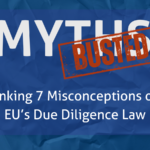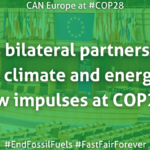Emissions reduction and climate finance, both before and after 2020 – these two hot topics in the international climate negotiations will absorb the EU high level representatives, who arrived to the negotiating table in Lima, Peru yesterday.
During the last three days of the talks, they will have to focus their diplomatic efforts on reaching crucial decisions on these two issues. Otherwise chances of a successful outcome of the climate summit in Paris next year, where the new international agreement on climate action after 2020 is to be finalized, will shrink like the Arctic sea ice in the summer.
During the first week of the UNFCCC climate summit in Lima, there has been little progress on bringing countries’ positions closer. Delegates only ensured that every single one of them is included in the draft negotiations text for the new Paris agreement.
The EU ministers and the EU Commissioner for Climate Action and Energy, who have just arrived to the conference in Lima, have to push forward certain decisions on emissions reductions and climate finance, which will be crucial for the successful conclusion of the agreement next year. This will determine whether we can speed up the ongoing transition of our economies away from reliance on fossil fuels that drive climate change and towards 100% renewable energy by 2050.
Contributions that really make a difference
By end of March 2015, countries are due to table their new post-2020 emission reduction targets for the Paris agreement. In the climate negotiations jargon they are known as the “Intended Nationally Determined Contributions” (INDCs).
A key outcome in Lima is a decision that will set guidelines for the INDCs. It is important that they are transparent, quantifiable and comparable, in order to allow any kind of assessment and revision of their adequacy and fairness. We need to compare and add up the pledges to understand whether or not they collectively allow for keeping the temperature rise on a level where climate change does not spin out of control and threaten civilization as we know it. CAN Europe has been happy to see the EU calling for clarity of details in the INDCs, as well as an assessment and revision of the new targets before Paris.
Looking critically at the current political environment, it is likely that the INDCs that countries will put forward in Paris will be too low. The best way to limit their inadequacy is to review them frequently. The EU ministers should make sure that these contributions refer to a short period of time, e.g. five years as opposed to 10 years. Short commitment periods combined with a long term goal of phasing-out fossil fuels by 2050 would enable to capture the huge gains being made on the technology front and lesson learned in policy implementation.
No finance, no deal
For many developing countries, reducing emissions whilst also adapting to the impacts of climate change will require support in the form of finance, technology transfer and enabling environments. This is where the EU needs to be more ambitious.
Despite re-iterating that finance will play a key role in the 2015 agreement, the EU is doing little to reassure developing countries and NGOs that this is the case. It stands a firm position on not including finance as a requirement in countries’ intended contributions, but has done little to showcase other ways to deal with it.
Promises to deliver
Developed countries agreed to increase climate finance for developing countries to $100 billion a year goal by 2020. So far $9.9 billion has been pledged, which is the much needed start. Now we need a climate finance roadmap that can scale up public finance flows and commitments to reach the promised amount. Such a roadmap can provide the needed clarity and predictability around climate finance flows. It can also allow contributing countries to spell out the sources of finance, as well as the channels and instruments that are being deployed. African and Latin American countries are pushing for it. If they don’t see any credible path for developed countries to deliver their promise, the odds of a deal in Paris go way down.
Actions that cannot be delayed
Commitments and action between now and 2020 are the stepping stones to continued and increased climate action for the years after. Waiting with the efforts only for after 2020 will make meeting the Paris pledges much harder. The science is clear, the carbon emissions need to be phased-out completely within the next few decades. The sooner we start, the easier it will be.
With this in mind, the EU should continue to showcase key specific actions that countries are doing on the ground to reduce their greenhouse gas emissions. Germany set a good example last week through its commitment to further phase out coal. France announced that no more support will go to coal through its export credit agencies. As a whole Europe must meet its target to reduce energy consumption by 20% by 2020 against projections, phase out all fossil fuel subsidies immediately, and agree on a fundamental reform of its Emissions Trading Scheme before the Paris Climate Summit.



